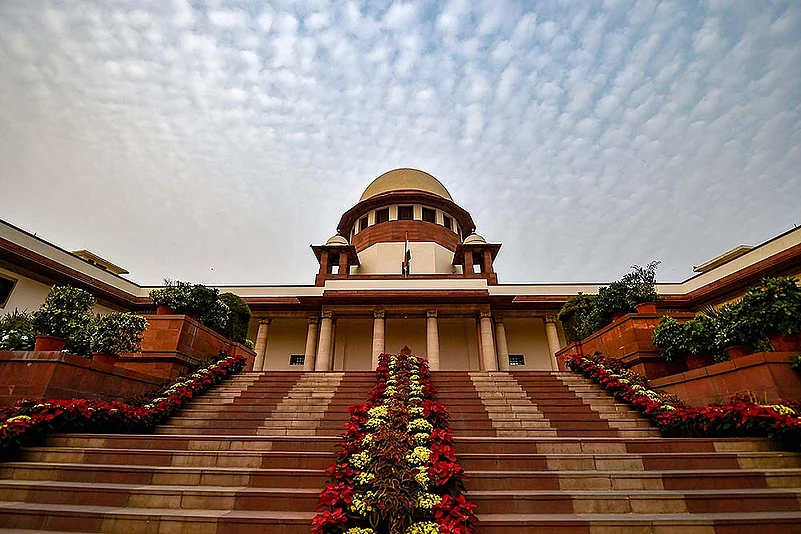In September 2018, the Supreme Court passed a judgment in Swapnil Tripathi vs. Supreme Court of India, stating the need to live stream court proceedings to the public with appropriate safeguards. The judgment was extensive and well-reasoned, taking stock of the practices around the world and the existing jurisprudence of the Apex Court. Justice A. N. Khanwilker, writing for the majority, directed that the Supreme Court Rules, 2013 be amended and the framework of live streaming is included in the same.
In February 2020, with regard to the implementation of the 2018 judgment, the Supreme Court stated that the matter shall be dealt by the Chief Justice of India on the administrative side with a remark, “Can we issue a command to the parliament to frame this or that law? Let the matter be examined on the administrative side by the CJI.”
Advertisement
In an order dated April 6, 2020, the Supreme Court issued guidelines for matters to be taken up through video conferencing and gave powers to High Courts around the country to come up with procedures of their own. Post this, the Bombay, Orissa and Kerala High Court chose to conduct hearings with open access and live streaming on the Zoom Application. However, the Bombay High Court and the Orissa High Court have since discontinued the use of application, considering the advisory of the Ministry of Home Affairs. The Supreme Court, on the other hand, has operated through an application called VIDYO but advocates have complained of being left out of hearings for the reason that limited number of parties can join and the same cannot be viewed publicly.
Advertisement
The Supreme Court Bar Association passed a resolution on April 2 which urges the top court inter alia to begin to live stream the court proceedings which are taking place through video conferencing. Apart from the implementation of the Tripathi judgment, and the various technological challenges that are being faced by the Counsels, there are several other reasons as to why the Supreme Court should expedite the amendment of rules for live streaming of court hearings.
Accessibility to Law and its Procedure
The labyrinth and intimidation of law has been most succinctly put forward by Franz Kafka in his short parable titled Vor dem Gesetz or Before the Law. As gatekeepers of the law, the Supreme Court and all other officers of the court must strive to make the law more accessible to the common man, so that we do not descend into the world that Kafka imagined.
One of the biggest impediments to free access of justice is the intimidating nature of the machinery of law. Live streaming of proceedings shall demystify this image by bridging what may be termed by economists as an information asymmetry.
Just as the Parliament of the country makes laws for the general populace, the Supreme Court, through interpretation, often clarifies and crystallises the law of the land. The Supreme Court has also often stepped in and filled up lacunae by actively creating laws such as the Vishakha guidelines. While it is a well agreed principle across Common Law jurisdictions that ‘ignorance of law’ cannot be taken as a defence, and therefore active efforts should be taken to bring the common man closer to the machinery which creates the law. In the same spirit, just as the proceedings of the Lok Sabha and the Rajya Sabha are streamed live, the proceedings within the Supreme Court too should be streamed.
Advertisement
Another important parallel that may be drawn between the Parliament and the Supreme Court is the rich source of scholarship that may not be recorded in the final law and judgments, respectively. While the Parliament publishes the text of debates in addition to the live streaming and videos, the scholarship that is presented before the Supreme Court is lost, if not recorded in the judgment. This lost scholarship may be extremely helpful to future practitioners and even the general public and hence, the need to live stream and publish videos is amplified.
Public Confidence and Scrutiny
The Supreme Court, through a 9-judge bench in Naresh Shridhar Mirajkar vs. State of Maharashtra, has stated in clear terms the need for open court hearings as public scrutiny “serves as a powerful instrument for creating confidence of the public in the fairness, objectivity, and impartiality of the administration of justice.”
Advertisement
Live streaming of court proceedings shall ensure that all officers of the court, including judges, advocates and even the staff are held to a high ethical standard. In addition, it shall keep a check on the litigants who appear or attend proceedings within the court complex.
Live streaming may also help in increasing efficiency as judicial officers may not engage in dilatory tactics to maintain their reputation before the public, who shall have access to the proceedings in real time.
Why Now?
While the Supreme Court has been extremely proactive in providing access to justice through video conferencing, the number of functional benches and the number of matters being taken up are limited as compared to the general functioning of the court. The limited matters give an opportunity to the court to easily choose which of them should be streamed and which to be left out.
Advertisement
Further, for the video conferencing feature, limited infrastructure needs to be added to the existing mechanism. While live streaming during normal functioning of the court would have required cameras and microphones, only software additions need to be made to stream video conferences.
At this time of an international health emergency, the public confidence in all organs of the state has to be boosted. At the end of the day, not only must justice be done, it must also be seen to be done.
(The author is a practicing Advocate at the High Court of Delhi. He has earlier served as a Research Fellow at Centre for New Economic Studies, Jindal Global University. Views expressed are personal.)




















